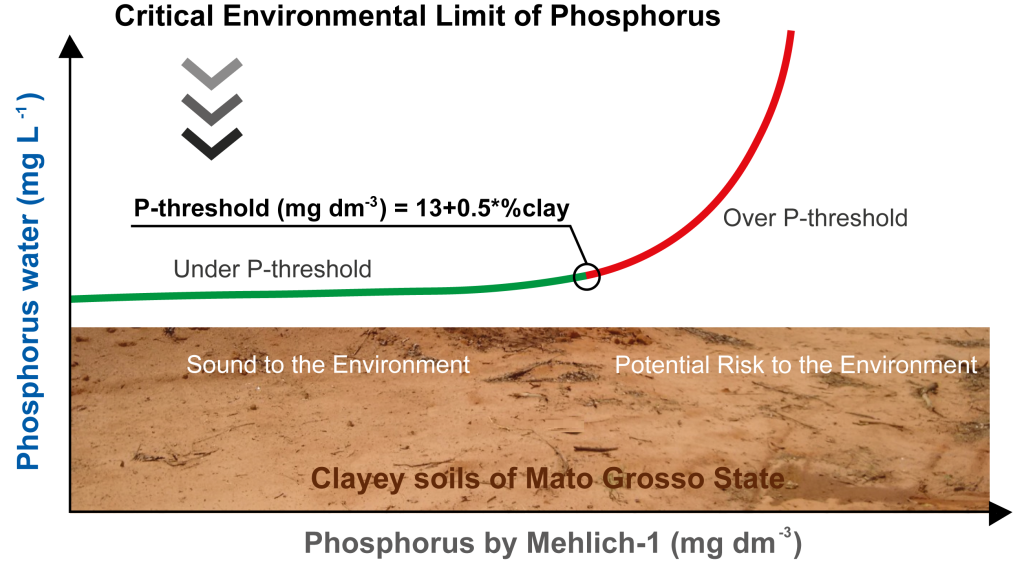Establishing environmental soil phosphorus thresholds to mitigate its transfer to water bodies in Mato Grosso State, Brazil
28/Nov/2023
ABSTRACT Excessive phosphorus (P) applications can increase nutrient levels in the soil, facilitating its transference to aquatic environments and causing contamination. Thus, the environmental P threshold (P-threshold) is a tool to establish a sound level of P in the soil, in which P values below the threshold are harmless to the environment. This study aimed to establish a P-threshold equation for the soils of Mato Grosso State, Brazil. Twenty samples of representative soils from the main swine production regions of […]
Phosphorus Forms in Sediments as Indicators of Anthropic Pressures in an Agricultural Catchment in Southern Brazil
21/Nov/2017
ABSTRACT Phosphorus (P) fractionation is a suitable procedure to ascertain P lability in sediments and is able to distinguish sources of P under different soil management practices in a catchment. Brazil is the second largest producer and the largest exporter of tobacco in the world. Inadequate management of cultivated areas exposes the soil to erosion processes, accelerating the transfer of sediment and P to water bodies, which leads to eutrophication. We evaluated the P forms in suspended sediments collected at […]
SOIL PHOSPHORUS THRESHOLDS IN EVALUATING RISK OF ENVIRONMENTAL TRANSFER TO SURFACE WATERS IN SANTA CATARINA, BRAZIL
01/Jul/2015
The State of Santa Catarina, Brazil, has agricultural and livestock activities, such as pig farming, that are responsible for adding large amounts of phosphorus (P) to soils. However, a method is required to evaluate the environmental risk of these high soil P levels. One possible method for evaluating the environmental risk of P fertilization, whether organic or mineral, is to establish threshold levels of soil available P, measured by Mehlich-1 extractions, below which there is not a high risk of […]
LAYERED DOUBLE HYDROXIDES: NANOMATERIALS FOR APPLICATIONS IN AGRICULTURE
01/Jan/2015
The current research aims to introduce Layered Double Hydroxides (LDH) as nanomaterials to be used in agriculture, with particular reference to its use as storage and slow release matrix of nutrients and agrochemicals for plant growing. Structural characteristics, main properties, synthesis methods and characterization of LDH were covered in this study. Moreover, some literature data have been reported to demonstrate their potential for storage and slow release of nitrate, phosphate, agrochemicals, besides as being used as adsorbent for the wastewater […]
Phosphorus fractions in sandy soils of vineyards in southern Brazil
01/Apr/2013
Phosphorus (P) applications to vineyards can cause P accumulation in the soil and maximize pollution risks. This study was carried out to quantify the accumulation of P fractions in sandy soils of vineyards in southern Brazil. Soil samples (layers 0-5, 6-10 and 11-20 cm) were collected from a native grassland area and two vineyards, after 14 years (vineyard 1) and 30 years (vineyard 2) of cultivation, in Santana do Livramento, southern Brazil, and subjected to chemical fractionation of P. Phosphorus […]
Chemical phophorus extractors used as environmental indicators in sewage-sludge treated soil
01/Aug/2010
Sewage sludge (SS) application to agricultural soils can raise the levels of some nutrients inadequately, for example P. In practice, the applied SS doses are based on the N requirement of crops, in which the P requirement or final destination of the applied P in the residue is not taken into account. Phosphorus is often associated with the eutrophication of water bodies, for being transported by runoff. The objective of this study was to evaluate if three chemical extractors used […]
Mobility of inorganic and organic phosphorus forms under different levels of phosphate and poultry litter fertilization in soils
01/Aug/2010
The eutrophication of aquifers is strongly linked to the mobility of P in soils. Although P mobility was considered irrelevant in a more distant past, more recent studies have shown that P, both in organic (Po) and inorganic forms (Pi), can be lost by leaching and eluviation through the soil profile, particularly in less weathered and/or sandier soils with low P adsorption capacity. The purpose of this study was to determine losses of P forms by leaching and eluviation from […]
Water, soil and phosphorus loss after cattle slurry application to oxisol under no-tillage and simulated rainfall
01/Feb/2009
Campos Gerais in the State of Paraná (Brazil) is an important region of milk production and consequently of cattle slurry. The purposes of this study were: (a) to evaluate losses of water, soil, total P, soluble P and particulate P under simulated rainfall performed immediately after the application of 0, 30, 60 and 90 m3 ha-1 cattle slurry on a Red-Yellow Latossol (Ferralsol) under no-tillage system, and (b) to discuss the possible impacts on water quality. Slurry application increased the surface runoff […]
Soil phosphorus alteration by pig slurry application
01/Dec/2008
Pig slurry serves as plant nutrient source, but may cause phosphorus accumulation in the soil when used improperly, which later can be transferred to the aquatic environment causing eutrophication. The objective of this study was to evaluate the potential risk of environmental contamination by continuous use of pig slurry, measuring alterations in phosphorus content in the soil and in the sorption isotherms. The study was carried out at the Universidade Federal de Santa Maria, in a Typic Hapludalf. The effects […]

